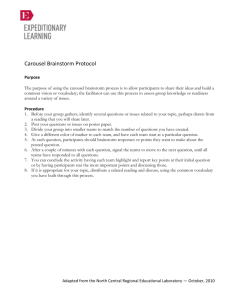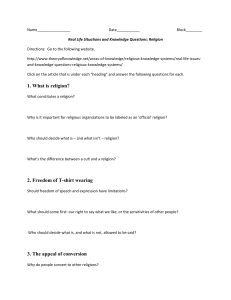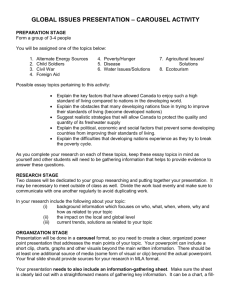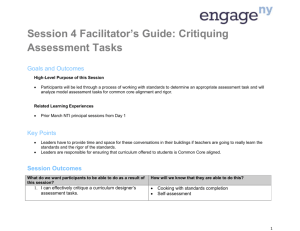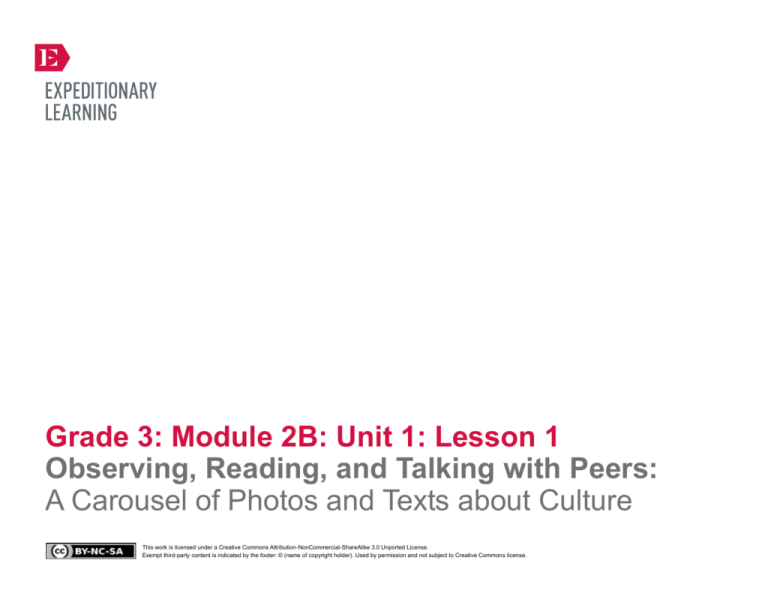
Grade 3: Module 2B: Unit 1: Lesson 1
Observing, Reading, and Talking with Peers:
A Carousel of Photos and Texts about Culture
This work is licensed under a Creative Commons Attribution-NonCommercial-ShareAlike 3.0 Unported License.
Exempt third-party content is indicated by the footer: © (name of copyright holder). Used by permission and not subject to Creative Commons license.
GRADE 3: MODULE 2B: UNIT 1: LESSON 1
Observing, Reading, and Talking with Peers:
A Carousel of Photos and Texts about Culture
Long-Term Targets Addressed (Based on NYSP12 ELA CCLS)
I can ask and answer questions to deepen my understanding of a literary text. (RL.3.1)
I can ask and answer questions to deepen my understanding of informational text. (RI.3.1)
I can effectively participate in a conversation with my peers and adults (SL.3.1)
Supporting Learning Targets
Ongoing Assessment
• I can talk with my partner or group to reflect and record what I notice and wonder about pictures and
text.
• Students’ contributions to conversation norms
• I can follow our class norms when I participate in a conversation.
• Mystery Pictures and Excerpts: Personal Reflection
recording form
Copyright © 2013 by Expeditionary Learning, New York, NY. All Rights Reserved.
• Observation of discussions
NYS Common Core ELA Curriculum • G3:M2B:U1:L1 • June 2014 •
1
GRADE 3: MODULE 2B: UNIT 1: LESSON 1
Observing, Reading, and Talking with Peers:
A Carousel of Photos and Texts about Culture
Agenda
Teaching Notes
1. Opening
• This module opens in a similar way to Module 1, with a Carousel Brainstorm protocol. The Carousel
Brainstorm protocol is a simple way to engage students with new content, in this case components of
culture, by getting them up moving, thinking, and talking. In this lesson, students look at some images
to pique their curiosity. The images will need to pertain to world cultures from countries around the
world. Students also examine text excerpts from both literary and informational texts that pertain to the
culture of ancient Japan. Do not reveal what the images or excerpts are about.
A. Unpacking Learning Targets (2 minutes)
B. Practicing Observing Closely: I Notice/I Wonder (5
minutes)
2. Work Time
A. Carousel Protocol: Images of Culture (20 minutes)
• Do not tell students the guiding questions for the module until the end of the lesson.
B. Debriefing the Carousel (20 minutes)
• During this unit, students will use a variety of recording forms to respond to their reading and develop
vocabulary. Consider developing a workable organization system to help students keep track of their
materials; a folder, binder, or notebook could be used for this purpose (see the Module Overview,
Preparation and Materials section).
3. Closing and Assessment
A. Student Written Reflection (5 minutes)
B. Debrief (8 minutes)
4. Homework
A. Tell an adult you know about the photographs you
saw and the text excerpts you read. What will you
learn about in the coming weeks?
• In Work Time A, as students have conversations about what they notice and wonder, use the
Conversation Criteria checklist to assess their ability to follow the conversation norms. Adapt this
checklist to suit your personal preferences. Before the lesson, review the targeted conversation norms to
assess students’ ability to engage effectively in collaborative discussions.
• In advance:
– Locate seven photographs/illustrations to use for the lesson (one for modeling, six for the carousel).
Of the six photographs for the carousel, try to find images that show customs and traditions from
around the world. The photographs/illustrations could come from magazines or an internet search.
They can be of any country you choose. These pictures are intended to arouse curiosity and serve as a
“mystery” for the forthcoming study of culture. Note: The pictures do not need to match the excerpts.
Do not reveal what the photographs/illustrations are about, or tell students the guiding questions for
the module.
– Post 12 Carousel Station charts around the room (see sample in supporting materials). Six of the
charts will each have one of the photographs/illustrations, with the phrase “What I Notice/What I
Wonder” written below the photo/image. Six additional charts will each have one of the excerpts,
with the phrase “What I Notice/What I Wonder” written below the excerpt. There will be 12 charts
total. See sample in supporting materials.
Copyright © 2013 by Expeditionary Learning, New York, NY. All Rights Reserved.
NYS Common Core ELA Curriculum • G3:M2B:U1:L1 • June 2014 •
2
GRADE 3: MODULE 2B: UNIT 1: LESSON 1
Observing, Reading, and Talking with Peers:
A Carousel of Photos and Texts about Culture
Agenda
Teaching Notes (continued)
– Post Class Norms for Discussion anchor chart (from Module 1, Unit 1, Lesson 4) or create a new
chart. During this lesson, students identify norms for a quality classroom conversation (e.g., everyone
gets a chance to speak, students ask questions of one another to extend conversation, etc.).
– Review: Think-Pair-Share and Carousel Brainstorm protocols (see Appendix).
Lesson Vocabulary
Materials
notice, wonder, reflect, norms, record,
details, excerpt
• Class Norms for Discussion anchor chart (from Module 1, Unit 1, Lesson 4; one to display)
• Document camera
• Photograph/illustration for modeling (one for modeling in Opening B; see Teaching Notes)
• What I Notice/What I Wonder T-chart (new; co-created with students; see Opening B)
• Mystery text excerpt for Opening B (one to display)
• Carousel Station charts (12 total; see Teaching Notes and sample in supporting materials)
• Markers (one per group of four students; ideally a different color for each group)
• Conversation Criteria checklist (from Module 1; provided again here for ease of reference; one for teacher reference)
• Mystery Pictures and Excerpts: Personal Reflection recording form (one per student)
• Guiding Questions anchor chart (new; teacher-created)
Copyright © 2013 by Expeditionary Learning, New York, NY. All Rights Reserved.
NYS Common Core ELA Curriculum • G3:M2B:U1:L1 • June 2014 •
3
GRADE 3: MODULE 2B: UNIT 1: LESSON 1
Observing, Reading, and Talking with Peers:
A Carousel of Photos and Texts about Culture
Opening
Meeting Students’ Needs
A. Unpacking Learning Targets (2 minutes)
• Congratulate students on their successful completion of Module 1. They learned a lot and took great strides to become better
readers and writers. Tell students it’s time to move on to the next module.
• Provide an illustrated anchor chart
of question words (e.g., a clock for
when) to assist students needing
additional support with learning the
structures needed to ask questions.
• Orient students to today’s learning targets. Circle the key terms notice and wonder. Ask students to talk with a partner about
what these words mean. Ask a few volunteers to share out to check for understanding.
• Review the Class Norms for Discussion anchor chart (from Module 1, Unit 1, Lesson 4).
• Remind students that these are targets they have worked with before. Today they will practice with different pictures, in
addition to text excerpts, as they begin their new topic of study as readers and writers. Tell students that they will try to solve
a mystery today by looking at pictures and reading excerpts from text. As they are looking, reading, and discussing with
peers, their job is to try to figure out what they will study in this module based on the details they see in the pictures and text
excerpts. Briefly define excerpt in this context: a short part of a book.
• Consider providing nonlinguistic
symbols (e.g., a question mark over
a student’s head for ask questions,
or a magnifying glass over a picture
for find) to assist ELLs in making
connections with vocabulary. These
symbols can be used throughout the
year with posted targets.
• Some students may need other basic
vocabulary words clarified:
question, conversation, excerpt,
mystery.
B. Practicing Observing Closely: I Notice/I Wonder (5 minutes)
• Gather students whole group. Do not tell students the topic of the module. Present it as a mystery for them to puzzle
through.
• Place students in pairs or ask them to identify a person close to them with whom they can think and talk.
• Using a document camera, display one photograph/illustration for modeling, similar to the ones they will see
during the Carousel Brainstorm protocol in Work Time.
• Briefly review the I Notice/I Wonder process with students (which they should be familiar with from Module 1). For “What I
Notice,” tell students: “When we look at a picture, or a book, we notice details.” Ask students to identify the meaning of the
word details. Ask:
* “What details do you notice about this picture? For example, when I look at this picture, I notice … [discuss a detail from
picture] but it also makes me wonder … [insert a question].”
Copyright © 2013 by Expeditionary Learning, New York, NY. All Rights Reserved.
NYS Common Core ELA Curriculum • G3:M2B:U1:L1 • June 2014 •
4
GRADE 3: MODULE 2B: UNIT 1: LESSON 1
Observing, Reading, and Talking with Peers:
A Carousel of Photos and Texts about Culture
Meeting Students’ Needs
Opening (continued)
• Emphasize the importance of referring directly to what they see in the picture to help students continue to understand the
importance of evidence.
• Co-create a What I Notice/What I Wonder T-chart. Use Think-Pair-Share protocol. Give students about 30 seconds to
think, and then ask them to share with a partner what they noticed. Invite a few volunteers to share with the class the ideas
that their partner had. As students share, record their ideas in the What I Notice column on the T-chart.
• For “What I Wonder,” ask students now to think of and then share with a partner questions they had about the picture.
Record the questions students generate in the What I Wonder column. Use this opportunity to reinforce how to format a
question using correct ending punctuation.
• Display the mystery text excerpt for Opening B:
“The Japanese bow when they greet each other. A bow can also mean ‘thank you’ or ‘I beg your pardon.’
A small group of people, called the Ainu, is native to Japan. Their ancestors are thought to be the first people to live in
Japan. Most Ainu live on the island of Hokkaido. They fish and grow food in the same way as their ancestors.”
• Use the Think-Pair-Share protocol. Give students about 30 seconds to think, and then ask them to share with a partner what
they noticed about the excerpt. Invite a few volunteers to share with the class the ideas that their partner had. Using the
same T-chart, record students’ ideas in the What I Notice column of the T-chart.
• For “What I Wonder,” ask students now to think of and then share with a partner questions they had about the excerpt.
Record the questions students generate in the What I Wonder column.
• Note: It is important that students have this supported experience of noticing and wondering about images and text before
heading into the carousel. This is the first time excerpts are used with the I Notice/I Wonder carousel.
Copyright © 2013 by Expeditionary Learning, New York, NY. All Rights Reserved.
NYS Common Core ELA Curriculum • G3:M2B:U1:L1 • June 2014 •
5
GRADE 3: MODULE 2B: UNIT 1: LESSON 1
Observing, Reading, and Talking with Peers:
A Carousel of Photos and Texts about Culture
Work Time
Meeting Students’ Needs
A. Carousel Protocol: Images of Culture (20 minutes)
• ELLs can write “notices” in their
native language if they don’t know a
word in English. For students
needing additional support, notices
can also be drawn, circled, or
marked with a sticky note on the
pictures.
• Be sure to have set up 12 Carousel Station charts spread around the classroom:
– The six photographs/illustrations with a T-chart with the phrase “What I Notice/What I Wonder” written below
– The six text excerpt charts with a T-chart with the phrase “What I Notice/What I Wonder” written below (see sample in
supporting materials)
• Do not tell students the topic of the module or what the pictures or excerpts are about. Present this as a mystery for them to
puzzle through and wonder about.
• Tell students that they will be using Carousel Brainstorm protocol and remind them of their experience with this protocol in
Module 1. Explain that there are charts set up around the classroom. Each station has a photograph or image, or a text
excerpt chart. All charts have What I Notice/What I Wonder written on them to record students’ thinking.
• For students needing additional
support to complete multistep
directions, provide a step-by-step
visual of the protocol.
• Tell students that they will continue to become great readers during this study, encountering both literary and informational
texts. On the excerpt charts, they will find excerpts from both informational and literary text.
• Remind students: “When we look at a picture or read from a book, we notice details.” Ask students to identify the meaning of
the word “details.” Emphasize the importance of referring directly to what they see in the picture or read in the excerpt to
help students continue to understand the importance of evidence, and explain that they will write these details in the What I
Notice column of the T-chart.
• Remind students that when they “wonder,” they ask questions based on the details they see in the image or read in the
excerpt. They will write these questions in the What I Wonder column of the T-chart. Use this opportunity to reinforce how
to format a question using correct word order and ending punctuation.
• Ask each pair of students to join another pair to form groups of four.
• Briefly review expectations with students about this protocol: taking turns, making sure everyone gets to write, etc. Remind
students about good conversational norms. Refer back to the work started in Module 1 with the Class Norms for Discussion
anchor chart. Tell students that as they are working, you will be watching them and listening to their conversations, and that
you will be taking notes about what you see and hear.
Copyright © 2013 by Expeditionary Learning, New York, NY. All Rights Reserved.
NYS Common Core ELA Curriculum • G3:M2B:U1:L1 • June 2014 •
6
GRADE 3: MODULE 2B: UNIT 1: LESSON 1
Observing, Reading, and Talking with Peers:
A Carousel of Photos and Texts about Culture
Work Time (continued)
Meeting Students’ Needs
• Each group of four will begin at a different station for the carousel. Give students directions:
• When reviewing the graphic
organizers or recording forms,
consider using a document camera
to visually display the document for
students who struggle with auditory
processing.
1. Look carefully at the photograph or carefully read the excerpt.
2. Talk with your group about details you notice in the photograph or details within the excerpt.
3. Talk with your group about the questions you wonder about related to the photograph or excerpt.
4. Then, after you talk, use your marker to add to the chart in the same way you practiced as a class.
• Providing models of expected work
supports all learners but especially
supports challenged learners.
5. Remember to use question words for your wonderings: who, what, when, where, why, and how.
• Ask students if they have any clarifying questions about the task. Answer questions as needed.
• Start each group of four at one of the stations. Distribute one marker to each group.
• While students are working, circulate and use the Conversation Criteria checklist to assess how well students are
following the conversation norms. Every 2 or 3 minutes, students rotate to a new station. Use the transition points to briefly
reinforce the steps of the task. Gauge the time based on discussions groups are having.
• After students have completed a couple of the stations, take the opportunity to stop and praise them on their conversation
skills, and remind them of expectations if necessary.
• Time permitting, repeat until students have interacted with each photograph and excerpt.
• Note: It is important to end Work Time A after 20 minutes to allow for sufficient time to debrief the carousel. If students do
not get to all charts, leave the charts up for students to visit at other times during the day.
Copyright © 2013 by Expeditionary Learning, New York, NY. All Rights Reserved.
NYS Common Core ELA Curriculum • G3:M2B:U1:L1 • June 2014 •
7
GRADE 3: MODULE 2B: UNIT 1: LESSON 1
Observing, Reading, and Talking with Peers:
A Carousel of Photos and Texts about Culture
Work Time (continued)
Meeting Students’ Needs
B. Debriefing the Carousel (20 minutes)
• If it’s not possible for students to
visit all stations for the debrief,
given the physical limitations of the
classroom, make sure to have all
station materials with you in the
whole-group area for the debrief.
• Gather students whole group to debrief the carousel. Since each station had a photograph or excerpt, and a T-chart, consider
debriefing the carousel by traveling as a class to each station.
• As you debrief each station, ask students to take a few moments to reflect on what’s written on the T-chart. Then ask a
handful of students to share out what they noticed and wondered.
• Focus heavily on what students noticed about each of the images and excerpts. Be purposeful about leading students to state
that the photographs are showing things that seem to be in different places around the world. Students may be familiar with
the Magic Tree House series and may notice the names Jack and Annie. Confirm that there were some excerpts from a
Magic Tree House book, but don’t say which one.
• If necessary, make summary statements about the excerpts. For example: “With Excerpt 1, it seems as though we’re getting
an idea about behaviors that we see from people living in China or Japan since the text says they’re using chopsticks.”
• As you move the discussion to each new station, a key instructional move will be to help students look for patterns on the Tcharts. If you are physically traveling from station to station, take the T-charts with you and encourage students to look for
patterns on the T-charts.
• If they are not already assembled, gather students whole group in the normal meeting area of the classroom. Push students
to connect the carousel text excerpts and images. Ask:
* “How does what you see in the photographs connect to what you read in the excerpts?”
• Think-Pair-Share: Invite students to discuss what the big themes or ideas of this module might be. Model as needed. (For
example: “I see many _____, so I think we might be learning about _____.”)
• Students may want to say that the theme or idea of the module is about Japan. If students try to connect Japan to the
module’s theme, point out that none of the seven photographs were just about Japan. This should refocus their thinking.
• Invite volunteers to share out their ideas. Accept a range of answers that students can support based on what they saw,
discussed, and read today. Probe with statements such as: “Why do you think that?” or “How does that fit with what you saw
in the pictures and read in the text excerpts?” Remind students that their ideas have to take both the photographs and the
excerpts into consideration. This is a good opportunity to emphasize the importance of providing evidence, which will be
reinforced throughout the module.
Copyright © 2013 by Expeditionary Learning, New York, NY. All Rights Reserved.
NYS Common Core ELA Curriculum • G3:M2B:U1:L1 • June 2014 •
8
GRADE 3: MODULE 2B: UNIT 1: LESSON 1
Observing, Reading, and Talking with Peers:
A Carousel of Photos and Texts about Culture
Meeting Students’ Needs
Closing and Assessment
A. Student Written Reflection (5 minutes)
• Distribute the Mystery Pictures and Excerpts: Personal Reflection recording form to students. Go over the
directions and invite students to write about their thinking.
B. Debrief (8 minutes)
• Gather students whole group. Display the Guiding Questions anchor chart. Share the first guiding question for the
module:
* “What defines culture?”
• Posting sentence frames can assist
ELLs and other students needing
additional support in contributing
to classroom discussions.
• Explain that the images and text students examined today are all examples of the “culture” of different places. Ask: “Based
on your observations, what might the term ‘culture’ mean?”
• Note: It is important that you do not define the term “culture” for students at this point. Lessons 2 and 3 take students on a
close read of an informational article about culture. That is when they will begin to learn what this term means.
• Explain that the class will be doing some work in the next two lessons that will help them understand what the word means,
and also what the guiding question means.
• Share with students that they will return to this question often during the next few weeks. Tell students that they will also
learn about how authors share knowledge on a topic through research. Briefly discuss the word “research” with students and
show the other guiding questions for the module:
* “How do authors conduct research and build knowledge to inform their writing?”
* “How can authors share knowledge on a topic gained through research?
• Post these guiding questions somewhere prominent in the classroom.
• Mention to students that they will be reading a lot about different countries and cultures as a class. Point out that they also
have opportunities to build their expertise by reading even more books on their own.
Meeting Students’ Needs
Homework
• Tell an adult you know about the photographs you saw and the text excerpts you read. What will you learn about in the
coming weeks?
Copyright © 2013 by Expeditionary Learning, New York, NY. All Rights Reserved.
NYS Common Core ELA Curriculum • G3:M2B:U1:L1 • June 2014 •
9
Grade 3: Module 2B: Unit 1: Lesson 1
Supporting Materials
This work is licensed under a Creative Commons Attribution-NonCommercial-ShareAlike 3.0 Unported License.
Exempt third-party content is indicated by the footer: © (name of copyright holder). Used by permission and not subject to Creative Commons license.
GRADE 3: MODULE 2B: UNIT 1: LESSON 1
Mystery Text Excerpt for Opening B
The Japanese bow when they greet each other. A bow can also mean “thank you”
or “I beg your pardon.”
A small group of people, called the Ainu, is native to Japan. Their ancestors are thought to be the first
people to live in Japan. Most Ainu live on the island of Hokkaido. They fish and grow food in the same
way as their ancestors.
Copyright © 2013 by Expeditionary Learning, New York, NY. All Rights
Reserved.
NYS Common Core ELA Curriculum • G3:M2B:U1:L1 • June 2014 • 11
GRADE 3: MODULE 2B: UNIT 1: LESSON 1
Mystery Text Excerpts for Carousel Stations
Teacher Directions: Do not identify the texts that each excerpt is taken from. The source is listed here
for teacher reference only.
Station 1
(from page 38, Dragons of the Red Dawn)
At the entrance, Basho slipped off his sandals. Jack and Annie did the same.
They placed their sandals in a row of shoes that other people had left by the
door.
Inside the teahouse, cooks stirred steaming pots over a wood-burning stove.
People sat at long low tables, eating with chopsticks and drinking from small
cups. Several customers smiled shyly and bowed before Basho.
Station 2
(from page 15, Exploring Countries: Japan)
In the countryside, people live in wooden homes on farms or in small towns.
Most homes have at least one room styled in the Japanese tradition. Straw mats
called tatami cover the floor. People sit on cushions and sleep on thick pads
called futons.
Station 3
(from page 26, Exploring Countries: Japan)
The arts have been an important part of life in Japan for hundreds of years.
People enjoy going to a traditional theater. They see puppet plays set to music,
called bunraku. Kabuki features lively actors in colorful costumes and makeup.
The actors dance and perform the same way ancestors did hundreds of years
ago.
Copyright © 2013 by Expeditionary Learning, New York, NY. All Rights
Reserved.
NYS Common Core ELA Curriculum • G3:M2B:U1:L1 • June 2014 • 12
GRADE 3: MODULE 2B: UNIT 1: LESSON 1
Mystery Text Excerpts for Carousel Stations
Station 4
(from pages 44–45, Dragons of the Red Dawn)
A large ring had been marked off on the ground with straw. In the middle of the
circle, two enormously fat men squatted at opposite sides of the ring. Each man
looked as if he weighed more than four hundred pounds. They clapped their
hands. They each began stomping his feet.
“Who are they?” said Annie, her eyes wide.
Station 5
(from page 23, Exploring Countries: Japan)
Before eating, Japanese people say the word itadakimasu. It means “I receive
this food.” It is a way to thank the person who cooked the meal.
Station 6
(from page 95, Dragons of the Red Dawn)
“Thanks,” said Jack.
“Good-bye,” said Annie.
They both bowed to Basho.
Basho bowed to them. Then the great poet turned and left them. Falling cherry
blossoms floated on the wind as he walked away.
Copyright © 2013 by Expeditionary Learning, New York, NY. All Rights
Reserved.
NYS Common Core ELA Curriculum • G3:M2B:U1:L1 • June 2014 • 13
GRADE 3: MODULE 2B: UNIT 1: LESSON 1
Carousel Station Chart
(Sample, for Teacher Reference)
Image or Excerpt here:
What I Notice
Copyright © 2013 by Expeditionary Learning, New York, NY. All Rights
Reserved.
What I Wonder
NYS Common Core ELA Curriculum • G3:M2B:U1:L1 • June 2014 • 14
GRADE 3: MODULE 2B: UNIT 1: LESSON 1
Conversation Criteria Checklist
(Repeated from Module 1 for teacher use; adapt to suit personal preferences.)
Learning Targets:
• I can follow our class norms when I participate in a conversation.
• I can speak with complete sentences when I participate in group discussions.
(Teachers: Please insert the conversation norms from class to assess students’ ability to engage effectively in collaborative
discussions. Code responses based on the setting in which the criteria is observed. For example: P = Partner, G = Small Group, C
= Whole Class)
Student Name
Complete
Sentences
Norm 1
Copyright © 2013 by Expeditionary Learning, New York, NY. All Rights
Reserved.
Norm 2
Norm 3
Norm 4
Norm 5
NYS Common Core ELA Curriculum • G3:M2B:U1:L1 • June 2014 • 15
GRADE 3: MODULE 2B: UNIT 1: LESSON 1
Mystery Pictures and Excerpts: Personal Reflection Recording Form
Name:
Date:
Based on the photographs you saw, the excerpts you read, and the discussions you had with your
peers, what do you think you will be learning about in this module? Use evidence from your work to
support your thinking.
Copyright © 2013 by Expeditionary Learning, New York, NY. All Rights Reserved.
NYS Common Core ELA Curriculum • G3:M2B:U1:L1 • June 2014 •
16
GRADE 3: MODULE 2B: UNIT 1: LESSON 1
Guiding Questions Anchor Chart
“What defines culture?”
“How do authors conduct research and build knowledge to inform their writing?”
“How can authors share knowledge on a topic gained through research?
Copyright © 2013 by Expeditionary Learning, New York, NY. All Rights Reserved.
NYS Common Core ELA Curriculum • G3:M2B:U1:L1 • June 2014 •
17

